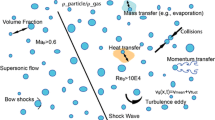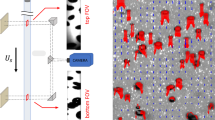Abstract
A method of indirectly measuring the temporally varying velocities of the gas and particulate phases in the nonequilibrium region of a shock wave moving at constant speed in a dusty-gas flow is described, and this method is assessed by using experimental data from shock-induced air flows containing 40-μm-diameter glass beads in a dusty-gas shock-tube facility featuring a large horizontal channel (19.7-cm by 7.6-cm in cross-section). Simultaneous measurements of the shock-front speed with time-of-arrival gauges, particle concentration by light extinctiometry and gas-particle mixture density by beta-ray absorption are used in conjunction with two mass conservation laws to obtain the indirect velocity measurements of both phases. A second indirect measurement of the gas-phase velocity is obtained when the gas pressure is simultaneously recorded along with the particle concentration and shock-front speed when used in conjunction with the conservation of mixture momentum. Direct measurements of the particulate-phase velocity by laser-Doppler velocimetry are also presented, as a means of assessing the indirect velocity measurement method.
Similar content being viewed by others
Abbreviations
- a f :
-
frozen speed of sound
- D :
-
particle diameter
- d f :
-
LDV interference fringe spacing
- d m :
-
LDV probe-volume diameter
- l m :
-
LDV probe-volume length
- M sf :
-
frozen shock Mach number
- M se :
-
equilibrium shock Mach number
- Ñ(D) :
-
probability density distribution by number
- p :
-
pressure
- R :
-
gas constant
- t :
-
time
- T :
-
temperature
- S :
-
LDV-signal amplitude
- v g :
-
gas velocity in laboratory frame of reference
- v p :
-
particle velocity in laboratory frame of reference
- V s :
-
shock-front velocity
- δ :
-
ratio of specific heats of particles and gas
- γ :
-
ratio of specific heats of gas
- Γ:
-
equilibrium specific heats ratio
- η :
-
particle-to-air loading ratio
- θ :
-
half-angle between incident laser beams
- λ :
-
laser light wavelength
- ϱ g :
-
gas density
- ϱ p :
-
particle material density
- σ g :
-
gas concentration
- σ m :
-
mixture concentration
- σ app m :
-
apparent mixture concentration
- σ p :
-
particle concentration
- ζ :
-
particle volume fraction
- \(\bar \zeta\) (D) :
-
probability density distribution by volume
References
Buckley, F. T. 1970: Drag measurements on particles in compressible flow by a light extinction method. A. I. A. A. J. 8, 1153–1155
Carlson, C. R.; Peskin, R. L. 1975: One-dimensional particle velocity probability densities measured in turbulent gas-particle duct flow. Intl. J. Multiphase Flow 2, 67–78
Czerwinski, W.; Deschambault, R. L.; Lock, G. D. 1987: Design of a dusty-gas shock-tube facility with preliminary experimental results. UTIAS Technical Note No. 263, University of Toronto
Durst, F.; Zare, M. 1975: Laser-Doppler measurements in two-phase flows. Proc. LDA-symp. Copenhagen, 403–429
Durst, F.; Ruck, B. 1987: Effective particle size range in laser-Doppler anemometry. Exp. Fluids 5, 305–314
Gottlieb, J. J.; Coskunses, C. E. 1985: Effects of particle volume on the structure of a partially dispersed normal shock wave in a dusty gas. University of Toronto, UTIAS report No. 295
Ingebo, R. D. 1956: Drag coefficient for droplets and solid spheres in clouds accelerating in air streams. NACA TN 3762
Karanfilian, S. K.; Kotas, T. J. 1978: Drag on a sphere in unsteady motion in a liquid at rest. J. Fluid Mech. 87, 85–96
Lock, G. D.; Gottlieb, J. J. 1989: Gas density and particle concentration measurements in shock-induced dusty-gas flows. Proc. 17th Intl. Symp. Shock Waves and Shock Tubes, Bethlehem, Pa.
Lock, G. D. 1991: An experimental investigation of the structure of a normal shock wave in a dusty gas. Ph.D. thesis, University of Toronto
Luger, P.: Hindelang F.; Hornung, K. 1987: Time resolved laser Doppler anemometry applied to shock waves in wet stream. Proc. 16th Intl. Symp. Shock Waves and Shock Tubes, Aachen, W. Germany
Miura, H.: Glass I. I. 1982: On a dusty gas shock tube. Proc. Roy. Soc. Lond. A382, 373–388
Miura, H.; Glass I. I. 1983: On the passage of a shock wave through a dusty-gas layer. Proc. Roy. Soc. Lond. A385, 85–105
Miura, H.; Glass I. I. 1985: Development of the flow induced by a piston moving impulsively in a dusty gas. Proc. Roy. Soc. Lond. A397, 295–309
Modarress, D.; Tan, H.; Elghobashi, S. 1984: Two-component LDA measurement in a two-phase turbulent jet. A. I. A. A. J. 22, 624–630
Murakami, T.; Ishikawa, M. 1978: Holographic measurements of velocity distribution of particles accelerated by a shock wave. Proc. of the 13th Intl. Congress on High Speed Photography and Photonics, Tokyo, 326–329
Outa, E.; Tajima, K.; Morii, H. 1976: Experiments and analyses on shock waves propagating through a gas-particle mixture. Bull. JSME 19, 384–394
Outa, E.; Tajima, K.; Suzuki, S. 1981: Cross-sectional concentration of particles during shock process propagating through a gas-particle mixture in a shock tube. Proc. 13th Intl. Symp. Shock Waves and Shock Tubes, Albany, U.S.A., 655–663
Rudinger, G. 1963: Experiments on shock relaxation in particle suspensions in a gas and preliminary determination of particle drag coefficients. ASME Multi-phase Flow Symp., New York, NY, U.S.A., 55–61
Rudinger, G. 1970: Effective drag coefficient for gas-particle flow in shock tubes. J. Basic Eng. 92D, 165–172
Rudinger, G. 1980: Fundamentals of gas-particle flow. Amsterdam: Elsevier
Selberg, B. P.; Nicholls, J. A. 1968: Drag coefficient of small spherical particles. A. I. A. A. J. 3, 401–408
Sommerfeld, M. 1985: The unsteadyness of shock waves propagating through gas-particle mixtures. Exp. Fluids 3, 197–206
Sommerfeld, M.; Gronig, H. 1983: The decay of shock waves in a dusty gas shock tube with different configurations. Proc. 14th Intl. Symp. Shock Waves and Shock Tubes, Sydney, Australia, 470–477
Soo, S. L. 1967: Fluid dynamics of multiphase systems. (Lexington: Blaidell)
Tempkin, S.; Kim, S. S. 1980: Droplet drag induced by weak shock waves. J. Fluid Mech. 96, part 1, 133–157
Torobin, L. B.; Gauvin, W. H. 1961: The drag coefficient of single spheres moving in steady and accelerated motion in a turbulent fluid. A. I. Ch. E. J. 7, 615–623
vom Stein, H. D.; Pfeifer, H. J. 1972: Investigation of the velocity relaxation of micronsized particles in shock waves using laser radiation. App. Opt. 11, 305–307
Author information
Authors and Affiliations
Rights and permissions
About this article
Cite this article
Lock, G.D. On the method of indirectly measuring gas and particulate phase velocities in shock induced dusty-gas flows. Experiments in Fluids 15, 1–9 (1993). https://doi.org/10.1007/BF00195589
Received:
Accepted:
Issue Date:
DOI: https://doi.org/10.1007/BF00195589




